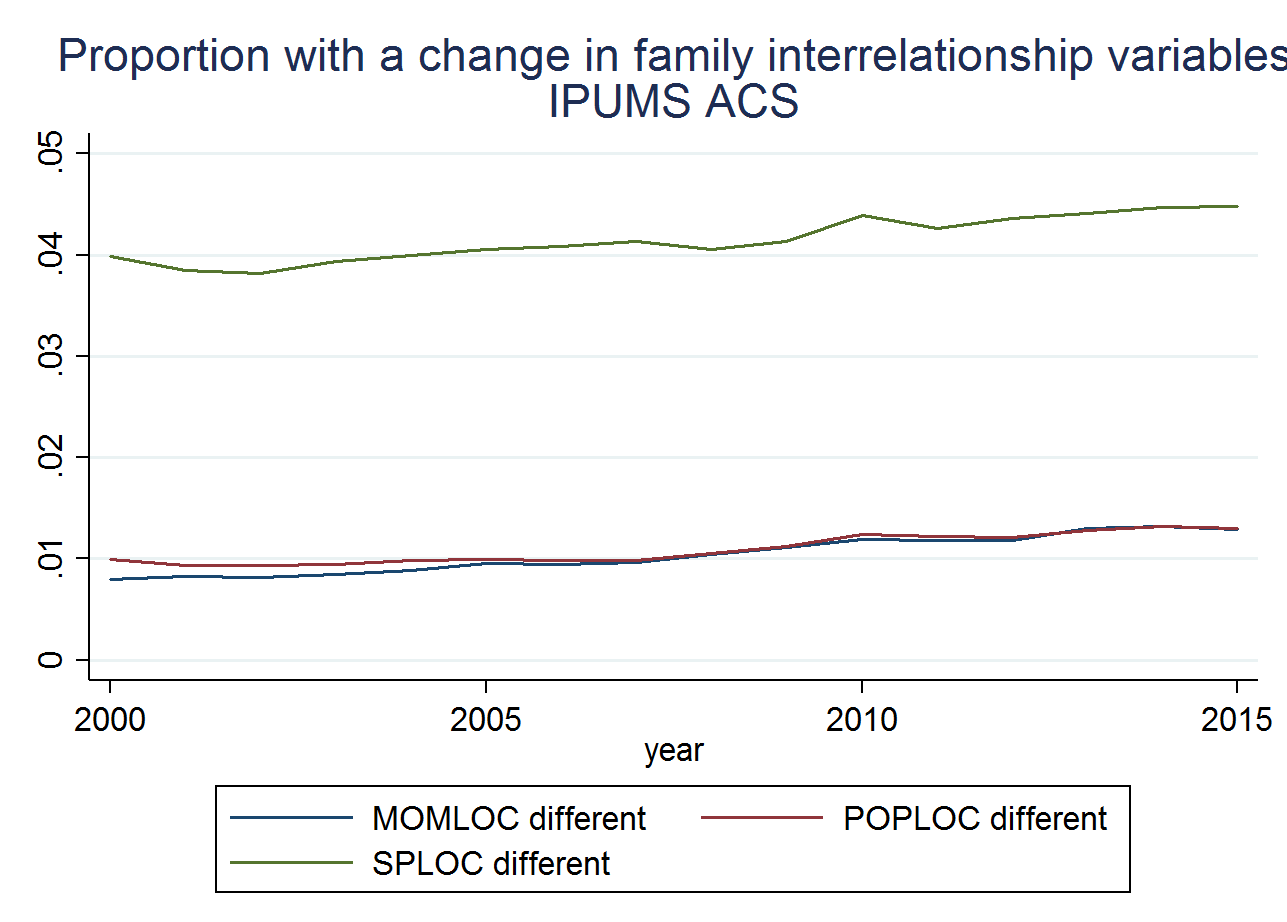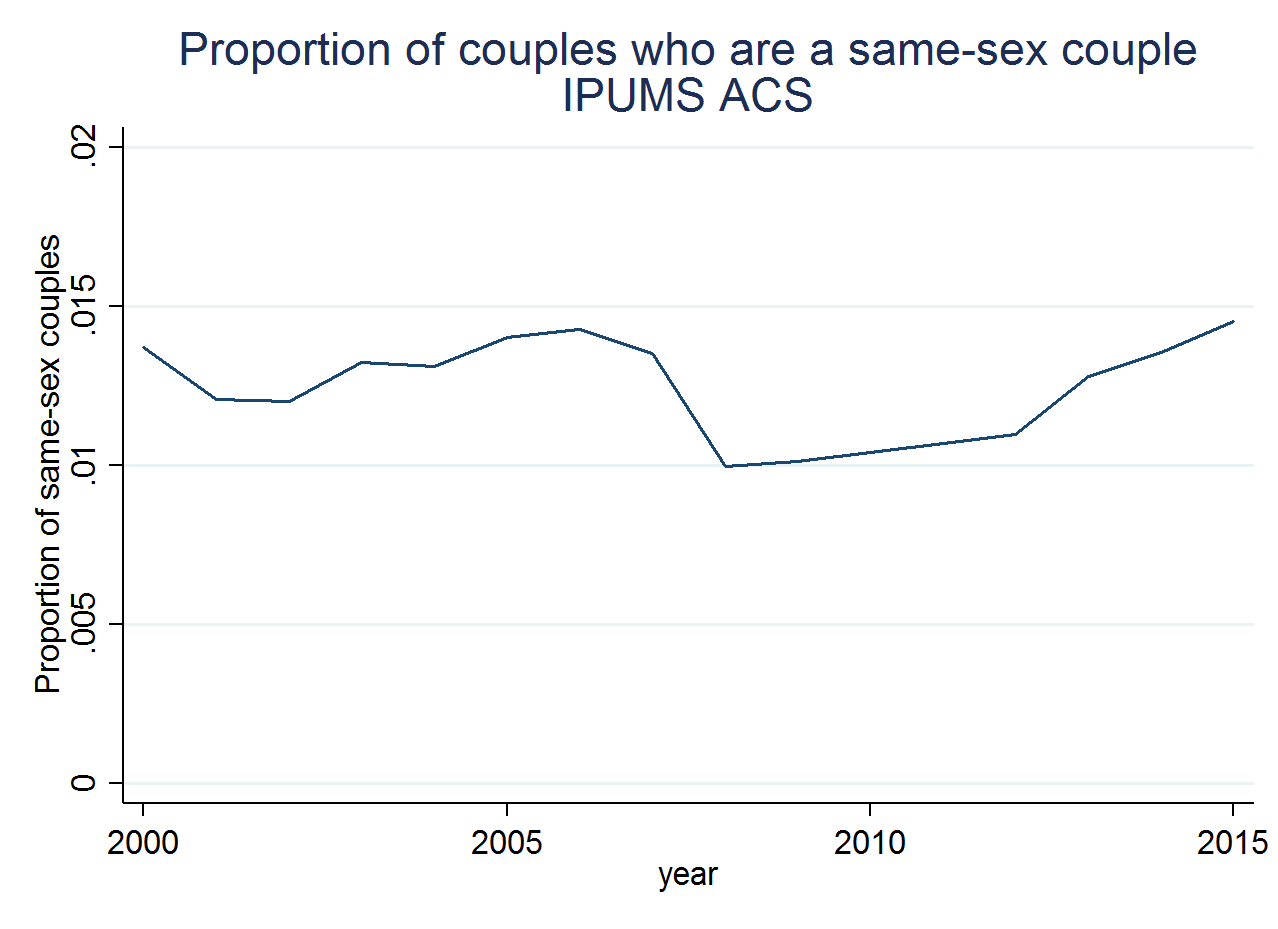New family interrelationship variables in IPUMS USA
IPUMS has made some small modifications to the family interrelationship variables in order to accomplish three important goals.
- Increase comparability across different data projects and over time
- Include same-sex couples and cohabiting couples
- Clearly communicate how the link was identified, so researchers can choose to include or exclude certain links
IPUMS USA has implemented new family interrelationship variables in samples from 1970 to the present. For 1960 and earlier, the previous family interrelationship variables are still in use. These variables are now labeled with a HIST suffix to avoid confusing them with the new family interrelationship variables. For 1970 to present, the previous version of the IPUMS family interrelationship variables and the other constructed family variables which depend on family interrelationship can be found HERE.
To accomplish these goals, the new family interrelationship variables have made multiple changes. The first three changes are relatively straightforward. First, SPLOC now links married and cohabiting relationships for same-sex and different-sex couples. Second, there are new variables (MOMLOC2 and POPLOC2) that allow parental links to include same-sex couples. Third, there are detailed variables that identify how a spousal or parental link was identified (SPRULE, MOMRULE, POPRULE).
The more complex change affects how IPUMS selects which parental or spousal links to identify when there are multiple potential links to select from. The new IPUMS family interrelationship variables use marital status, age, and sex when deciding among multiple potential parental or spousal links. In contrast to the previous family interrelationship variables, the new variables rarely use household order when deciding links. The logic behind selecting a link is the same across multiple IPUMS datasets, even when there are differences in the level of detail in RELATE.
The spouse location variable first links couples, both same-sex and different-sex, where there is only one potential spouse or partner. In households where there are multiple potential spouses, different-sex links are prioritized over same-sex links. When there are multiple potential different-sex spouses, relative age is used to pair up spouses. When there are two people of the same age, location in the household is used as a "tie breaker". Households that contain multiple same-sex couples are not paired in IPUMS USA data projects. We do not form these links because MARST does not contain enough information to differentiate households comprised of multiple married people living separately from their spouses from household that actually contain multiple married same-sex couples. The variable SPRULE indicates in which potential link was ultimately chosen for SPLOC.
Below are two example households from different datasets where IPUMS will select a spouse when there are multiple potential spouses. While the two datasets differ in detail of relationship to head, the logic used to assign SPLOC will be the same. In the first household, the 40 year old son of the householder could be married to either daughter-in- law of the householder.
| Person number | Relationship to head | Age | Marital status | Sex | Spouse location |
|---|---|---|---|---|---|
| 1 | Householder | 67 | Widow | F | |
| 2 | Child | 40 | Married, spouse present | M | 4 |
| 3 | Child | 35 | Married, spouse present | M | 5 |
| 4 | Child-in-law | 39 | Married, spouse present | F | 2 |
| 5 | Child-in-law | 34 | Married, spouse present | F | 3 |
SPLOC will use the relative ages of the potential spouses and indicate that the eldest son is likely married to the eldest daughter-in-law. Likewise, the younger son is likely married to the younger daughter-in-law.
However, another IPUMS dataset may not have "Child-in-law" as a possible value for "Relationship to Head." Many datasets would describe a "Child-in-law" as an "Other relative". This makes the spousal link less clear, because an "Other relative" could be married to many types of people, not just a child of the householder. The following household is very similar to the previous one, but now we have one son, and three other relatives - one male and two female.
| Person number | Relationship to head | Age | Marital status | Sex | Spouse location |
|---|---|---|---|---|---|
| 1 | Householder | 67 | Widow | F | |
| 2 | Child | 40 | Married, spouse present | M | 4 |
| 3 | Child | 35 | Married, spouse present | M | 5 |
| 4 | Other relative | 39 | Married, spouse present | F | 2 |
| 5 | Other relative | 34 | Married, spouse present | F | 3 |
SPLOC will make the same decision as before: The 40 year old son will marry the 39 year old female "Other relative." The 35 year old male "Other relative" will marry the 34 year old female "Other relative."
SPRULE will indicate the logical step was the same in both case, because in both cases age was used to select from multiple potential different-sex spouses. However, it will also show that the link in the first dataset was clearer than in the second, because of the finer detail in the relationship to head. For more detailed information, see the SPRULE variable description.
Similarly, when creating parental links, IPUMS uses marital status, age, and sex to decide the most likely parent. For example, married couples will be selected as parents prior to a single person. Single women will be selected before single men. Among multiple single women, the eldest is selected before younger women. If there are multiple children who could pair to multiple married parents, they are split by age. Among single women, all children are assigned to the eldest. These logical steps are the same across multiple IPUMS datasets.
As with SPRULE, MOMRULE and POPRULE will indicate the clarity of the link (e.g, Child to Grandchild) as well as how the choice was made if there were multiple potential parents. The specific meanings of MOMRULE's and POPRULE's values for each project are described in more detail in the variable descriptions.
Numerous IPUMS variables in multiple projects (IPUMS CPS, IPUMS Health Surveys, and ATUS-X) depend on the parental location variables, including number of children, number of children less than 5, age of eldest child, age of youngest child, and number of siblings. These variables now use the new IPUMS parental location variables. Additionally, IPUMS-USA uses the parental location variables for other measures, including family unit, family poverty, Hispanic origin and health insurance.
How much has changed?
The new family interrelationship variables are different for a very small proportion of respondents - the vast majority of respondents remain the same. Among IPUMS Census samples for 1970 and 1980, the proportion of respondents with a different value for family interrelationship variables is less than .2%. In 1990, "Unmarried partner" became an option on RELATE. For samples 1990 and 2000, the proportion of those with new values for SPLOC increases to 2% and 4% respectively. Among the IPUMS ACS samples, 4% to 5% of respondents have a new value for SPLOC. Changes in SPLOC are almost entirely due to including cohabiting and same-sex couples that were previously excluded from SPLOC. For example, in 2015 ACS 97.5% of people with a new SPLOC are cohabiting couples.

Around 1% of respondents in IPUMS ACS have new values for MOMLOC and POPLOC - these are concentrated in certain ambiguous parental links, particularly grandchild to child links. The previous family interrelationship variables used the order of people on the household roster to infer relationships, because parents are often listed immediately before their children. However, the public-use ACS is reordered by Census before being released, with household order based solely on RELATE and AGE. This means that the previous family interrelationship variables were making links based on household order, when order actually did not contain any meaning about families. As expected, we see changes in the ACS family interrelationships variables because the new variables no longer make this assumption.
An important change in the new family interrelationship variables is the inclusion of same-sex couples. In the IPUMS ACS samples, of all people we identify as in a relationship, between 1% and 1.5% are in same-sex couples.

There is a noticeable drop in the proportion of same-sex couples between 2007 and 2008, which reflects changes in the editing procedures from Census and a change in the layout of the questionnaire to reduce error in reported sex (see here for more information.).
Pre-2017 versions of IPUMS-USA family interrelationship variables can be found here.





